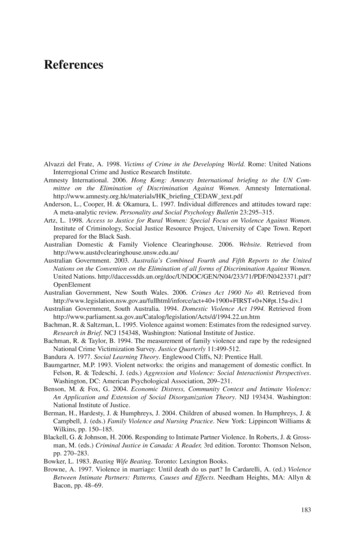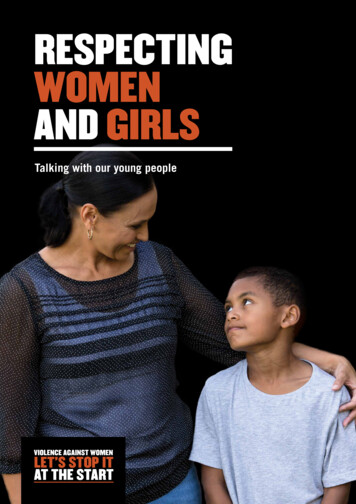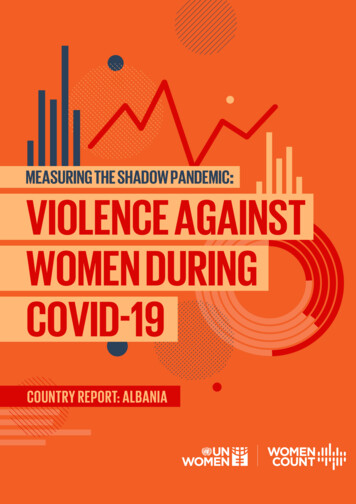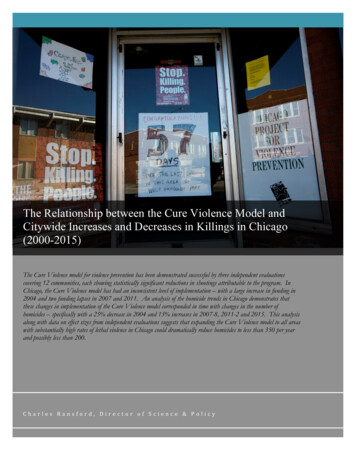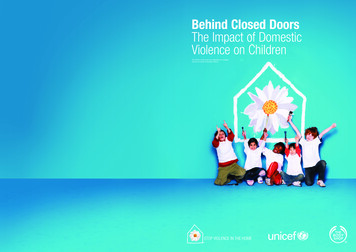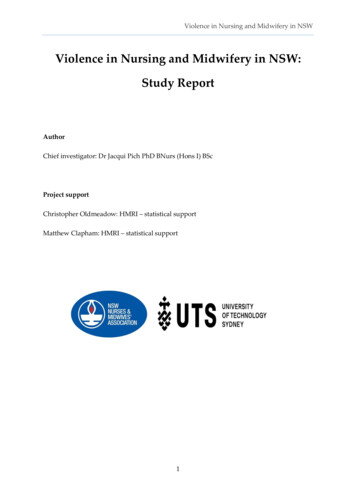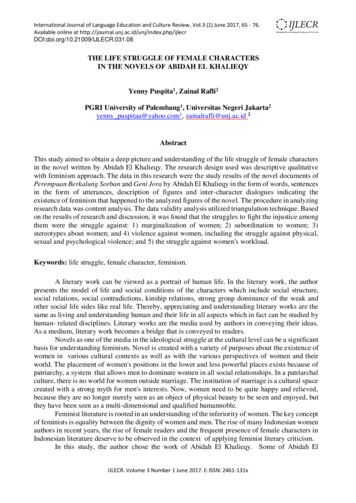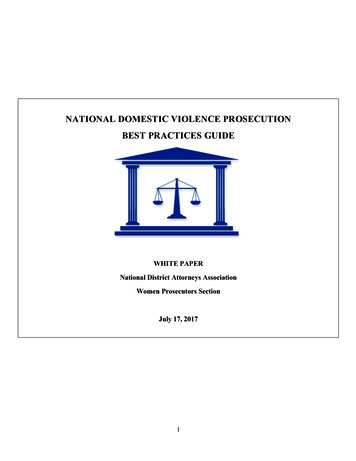
Transcription
Violence against women in AustraliaAn overview of research andapproaches to primary preventionvichealth.vic.gov.au
Acknowledgements:VicHealth would like to thank the authors and reviewers of this overview, includingDr Wei Leng Kwok, Dr Peta Cox, Ms Natalie Russell, Dr Emma Partridge and Ms Rebecca Zosel. VicHealth 2017January 2017 P-MW-442Suggested citation:Violence against women in Australia. An overview of research and approaches to primary prevention,Victorian Health Promotion Foundation, Melbourne, Australia.
Contents3About VicHealth446IntroductionKey concepts and definitionsThe gender-specific dynamics of violence against women77711111212Violence against women: prevalent and seriousLifetime prevalence estimatesHeightened risks and distinct circumstances of violenceThe health consequences of violenceSocial and economic costs of violenceChildren exposed to violence against womenCommunity attitudes towards violence against women14141515Responses to violence against women: policy, community and mediaPolicyCommunity and bystander actionMedia161616171818191921Primary prevention: actions to address the drivers of violence against womenSpotlight on primary preventionFrameworks to explain and address the drivers of violenceEmerging evidence in prevention programsEssential and supporting actionsSettings for actionPriority population groupsTechniques and methodologies for preventionEvaluation and monitoring in prevention22ReferencesFigures16Figure 1: The relationship between primary prevention and other work toaddress violence against women17Figure 2: Socio-ecological model of violence against women18Figure 3: Five essential actions required to reduce the gendered drivers ofviolence against womenTable20Table 1: Public health methodologies to prevent violence against women andevidence of effectiveness
In Australia, around one in threewomen has experienced physicalviolence since the age of 15 years.
About VicHealthThe Victorian Health Promotion Foundation (VicHealth) aimsto promote good health and prevent chronic disease for allVictorians. As part of the vision to promote better mental healthand wellbeing, over the last decade VicHealth has undertakenextensive research, programs and policy development toprevent violence against women.VicHealth’s Action Agenda for Health Promotion 2013–23 is a10-year plan for health promotion in Victoria and includes afocus on five strategic imperatives:policymakers and agencies with specific mandates for deliveryof prevention initiatives to embed the knowledge, tools andresources we have developed over the past decade.This overview presents a synopsis of the latest publishedresearch examining violence against women in Australia and itsprevention. It is an update of earlier editions of the Preventingviolence against women in Australia research summary(VicHealth 2008, 2011a) and includes responses to violenceagainst women and primary prevention actions. promoting healthy eating encouraging regular physical activity preventing tobacco use preventing harm from alcohol improving mental wellbeing (VicHealth 2013).As part of our action to improve mental wellbeing, and inalignment with the prevention recommendations of the RoyalCommission into Family Violence, VicHealth is integrating ourwork of preventing violence against women into the Victorianprevention system. That is, we are working closely withONLINE RESOURCESMore information about activity to preventviolence against women is available at:VicHealthwww.vichealth.vic.gov.auOur Watch : KEY FACTS AND FIGURES In Australia, two in every five women (41%) have experienced violence since the age of 15 years.-- Around one in three (34%) has experienced physical violence.-- Almost one in five (19%) has experienced sexual violence (ABS 2013). Women are most likely to be victimised by men who are known to them: their current or previous cohabiting intimatepartners and/or boyfriends or dates (ABS 2013). Violence against women is estimated to cost Australia 21.7 billion a year (PwC et al. 2015). In Australia, male intimate partner violence contributes more to the disease burden for women aged 18 to 44 years thanany other well-known risk factor like tobacco use, high cholesterol or use of illicit drugs (Webster 2016). The majority of Australians have good knowledge about violence against women and do not endorse attitudes that aresupportive of violence. However, one in five Australians thinks men should take control in relationships and be the headof the household, and more than one in four Australians thinks women prefer a man to be in charge (VicHealth 2014). Factors associated with gender inequality are the most consistent predictors of violence against women, and resultin gendered patterns of violence. These factors are known as the gendered ‘drivers’ of violence against women(Our Watch et al. 2015). The drivers of violence against women can be addressed through primary prevention strategies, utilising a rangeof techniques in everyday settings such as workplaces, schools and sports.VicHealth3
IntroductionViolence against women is widely recognised as a globalproblem of significant magnitude. It is an often invisible butcommon form of violence, and an insidious violation of humanrights. It has serious impacts on the health and wellbeing ofthose affected, and exacts significant social and economic costson communities and nations. At the international level, the United Nations has adoptedspecific targets to end all forms of discrimination and violenceagainst all women and girls everywhere within the globalSustainable Development Goals (United Nations 2015). Also at the international level, the World Health Organization(WHO) has given significance to the epidemic rates and severeconsequences of violence against women by naming maleintimate partner violence a leading public health concern forcountries around the world (WHO 2002). In Australia, two in every five women (41%) have experiencedviolence since the age of 15 years.-- around one in three (34%) has experiencedphysical violence-- almost one in five (19%) has experienced sexualviolence (ABS 2013). the condoning of violence against women men’s control of decision-making and limits to women’sindependence in public life and relationships rigid gender roles and stereotyped constructions ofmasculinity and femininity male peer relations that emphasise aggression and disrespecttowards women (Our Watch et al. 2015).These gendered drivers arise from discriminatory historical,economic and social structures, norms and practices. This meansthat they are deeply entrenched, but also that they are modifiableand not inevitable. In other words, violence against women canbe prevented from happening in the first place, that is, before itoccurs to anyone, through action to address these drivers.This is known as ‘primary prevention’, which is the key focus ofthis overview. For more information about primary preventionsee key concepts and definitions (page 4) and spotlight on primaryprevention (page 16). Violence against women costs Australia 21.7 billion a year(PwC et al. 2015).Key concepts and definitions In Australia, male intimate partner violence contributesmore to the disease burden for women aged 18 to 44 yearsthan any other well-known risk factor like tobacco use, highcholesterol or use of illicit drugs (Webster 2016).Violence is defined in the WHO’s World Report on Violenceand Health as:Violence against women is prevalent and serious, but it isalso preventable. While many factors are said to contributeto violence against women, research in the last decade hasfound that at the population level the two most significantdeterminants are: the unequal distribution of power and resources betweenmen and women an adherence to rigidly defined gender roles, or what it meansto be (and live as) masculine or feminine (VicHealth 2007).More recently, research conducted for Our Watch shows that atthe population level, gender inequality in public and private life isthe necessary underlying condition for violence against womento occur (Webster & Flood 2015). Based on this research, ashared framework for prevention action in Australia articulates4four distinct yet interconnected expressions of genderinequality as the drivers of violence against women:the intentional use of physical force or power, threatened oractual, against oneself, another person, or against a group orcommunity, that either results in or has a high likelihood ofresulting in injury, death, psychological harm, maldevelopmentor deprivation (WHO 2002).Violence against women is defined by the United Nations (UN) inthe Declaration on the Elimination of Violence against Women as:any act of gender-based violence that results in, or is likely toresult in, physical, sexual or psychological harm or suffering towomen, including threats of such acts, coercion or arbitrarydeprivation of liberty, whether occurring in public or privatelife (UN 1993).The definition of violence against women encompasses all formsof violence experienced by women because of their gender, orthat disproportionately affect women. This includes physical,sexual, emotional, cultural/spiritual and financial violence, and awide range of controlling, coercive and intimidating behaviour.Violence against women in Australia. An overview of research and approaches to primary prevention
Specific types of violence against women may be categorised as: physical violence: physical abuse and aggression such asslapping, hitting, kicking and beating sexual violence: rape, sexual coercion, unwanted sexualadvances or harassment, forced prostitution and traffickingfor the purposes of sexual exploitation psychological abuse: for example, intimidation, belittling,humiliation, and the effects of financial, social and othernon-physical forms of abuse coercive control: a range of controlling behaviour such asisolating women from their family and friends, monitoringtheir movements, or restricting their access to information,assistance and other resources stalking: repeated following, watching or harassing harmful cultural practices: dowry-related violence, femalegenital mutilation, and other practices harmful to women(WHO 2002; Our Watch 2014a).Violence against women can take forms that are both criminaland non-criminal in nature. Regardless of the form it takes,violence is most often used by perpetrators as a means toexercise some form of power or control over women(Our Watch 2014a).Violence against women is a violation of women’s rights andfreedoms as human beings, especially their entitlements toequality, security, liberty, integrity and dignity in political,economic, social, cultural and civil life. Violence against womenis discriminatory towards women. Australia has obligations toeliminate such discrimination as we are party to internationalhuman rights treaties, most significantly the UN’s Conventionon the Elimination of All Forms of Discrimination against Womenor CEDAW (United Nations 1979).Male intimate partner violence is a broad term used to describeviolence against women perpetrated by current or previousmale partners. The term includes men who are cohabiting orhave cohabited with the women concerned, and where violenceoccurred during and/or after their cohabitation, as well aspartners who do not / have not lived with these women (such asboyfriends or dates).Domestic violence and family violence refers to violenceperpetrated within the family or household context. They aremost often perpetrated by men against their women partnersor ex-partners, however these terms can also refer to elderabuse, some forms of child abuse and adolescent violenceagainst parents (State of Victoria 2016).For Victorian Aboriginal communities, family violence has abroader and more encompassing definition than that used innon-Aboriginal communities. It communicates a wide rangeof physical, emotional, sexual, social, spiritual, cultural andeconomic abuses that can occur within intimate relationships,families, extended families, kinship networks and communities(Aboriginal Affairs Victoria 2008; State of Victoria 2016). Whilethis model stresses the dynamics and effects of violenceon family, kinship and community as a whole, it is womenand children who are the primary victims of family violencein Victorian Aboriginal communities. Victorian Aboriginalwomen and children experience a disproportionate levelof family violence at the hands of men, both Aboriginal andnon-Aboriginal, compared to the general population (State ofVictoria 2016).There are three ways in which violence against women can beprevented, and each intervention type has distinct aims andtargets. Primary prevention refers to whole-of-populationinitiatives that target the primary (first or underlying)gendered drivers of violence against women with the aim thatviolence does not happen at all. This can be achieved through acombination of universal strategies as well as tailored actionsor strategies for different settings, groups and contexts.Primary prevention is distinguished from secondary prevention(also called ‘early intervention’), which works in more targetedways to stop early signs of violence in specific individuals,communities or contexts from escalating, and tertiaryprevention (also called ‘response’), which seeks to stop therecurrence of existing violence and/or minimise its impacts(Our Watch et al. 2015).The focus of this overview is on the prevalence, impact andpreventable nature of male intimate partner violence, and malesexual assault against women, both partner and non-partner.These are the two most common expressions of violenceagainst women in Australia. They are also the forms of violenceof most interest to the violence against women and preventionsectors, and for which reliable population prevalence estimatesare calculated by the Australian Bureau of Statistics (ABS)(Cox 2015).1In Australia, male intimate partner violence contributes more to the diseaseburden for women aged 18 to 44 years than any other well-known risk factorlike tobacco use, high cholesterol or use of illicit drugs.1The ABS measures the prevalence of interpersonal violence in Australia through the Personal Safety Survey (PSS). The survey focuses on the experiences ofphysical and sexual violence of women and men aged 18 years and over, since the age of 15 years. Physical violence involves any incidents of physical assaultand/or physical threat. Sexual violence involves any incidents of sexual assault and/or sexual threat (ABS 2013).VicHealth5
The gender-specific dynamics ofviolence against womenThere are several characteristics of women’s experiencesof violence that make it a distinctly gendered problem anddifferent to violence against men.Women are most likely to be victimised by men who areknown to them: their current or previous cohabiting intimatepartners and/or boyfriends or dates. Men are most likely to besubjected to violence by other men who are unknown to them.This difference is clearly seen in lifetime prevalence estimatesprepared by the ABS, and based on their latest Personal SafetySurvey (PSS). Estimates show that since the age of 15 years, andat least at one time in their lives: 1.5 million women have experienced violence by malecohabiting partners and almost a million (981,300) womenhave experienced violence by boyfriends or dates 0.9 million women have experienced violence by maleperpetrators unknown to them 0.4 million men have experienced violence by femalecohabiting partners and 0.3 million men have experiencedviolence by girlfriends or dates 3.0 million men have experienced violence by maleperpetrators unknown to them (ABS 2013).Women are also most likely to be physically assaulted in theirown homes or other private domains; men are most likelyto be physically assaulted in public places such as places ofentertainment (ABS 2013).The PSS is designed to capture Australians’ experiencesof violence as individual incidents, but not the contextualcomplexities of victimisation and perpetration. Other studiesare needed to nuance the data.In addition to the asymmetrical prevalence rates, researchshows that the impacts and consequences of intimatepartner violence are also not symmetrical for women andmen. For example, women are more likely than men to beafraid of, hospitalised by, or killed by their intimate partners(Our Watch et al. 2015). There are some very limited indicationsthat women subject their male partners to the same level ofsevere, terrorising and escalating violence as that which menperpetrate against their female partners; in other words,the patterns are not similar (WHO 2002).When men use violence against their female partners: it is often not a one-off incident but rather the result ofongoing patterns of behaviour involving continuing patternsof coercion and perpetration designed to intimidate,undermine, isolate and create fear and control (State ofVictoria 2016) it is often severe with multiple and concurrent formsof victimisation used – physical, sexual, psychological,emotional, financial and technology-facilitated violence(State of Victoria 2016) it is more likely to have serious and lasting impacts, includinghospitalisation, and is more likely lead to death/murder (OurWatch et al. 2015).Research has established that men can also be victims ofintimate partner violence, from female and also same-sex malepartners (State of Victoria 2016). Research into women’s useof coercive control suggests that it is usually motivated by fearand self-defence in the context of violence that is already beingperpetrated against them by their male partners (WHO 2002;Swan et al. 2008).In Australia, almost one in five women has experienced sexual violencesince the age of 15 years.6Violence against women in Australia. An overview of research and approaches to primary prevention
Violence against women:prevalent and seriousLifetime prevalence estimatesThe WHO estimates that, at least once in their life, over one inthree women worldwide (35%) has experienced either intimatephysical and/or sexual partner violence or non-partner sexualviolence (WHO 2013). UN Women states that these figures makeviolence against women ‘one of the most significant issues to beaddressed in our time’ (UN Women 2015).How do the lifetime prevalence estimates for women inAustralia compare? Figures based on the latest PSS reveal thatfor women from the age of 15 years, Australia is no different tothe global picture. Two in every five women (41%) have experienced violence atleast once in their lives:-- around one in three (34%) has experienced physical violence-- almost one in five (19%) has experienced sexual violence(ABS 2013). 39 per cent of women have experienced physical and/orsexual violence from male perpetrators (ABS 2013). One in every three women (34%) has experienced physicaland/or sexual violence from a man known to them:-- almost one in six (17%) by a current or previouscohabiting partner-- one in nine (11%) by a boyfriend or male date (ABS 2013). One in every four women (25%) has experienced violencefrom male intimate partners, including physical and sexualthreats. In addition:-- one in five women (20%) has experienced physical assault-- one in eleven women (9%) has experienced sexual assault(Cox 2015). One in ten women (10%) has experienced violence from malestrangers (ABS 2013). Almost one in six women (17%) has been stalked by a man(ABS 2013).Multiple victimisation, whether in the different forms of violenceexperienced or the number of violent incidents, is also commonfor women in Australia:When women experience repeated incidents of physicalviolence, the perpetration is most often by the same man; whenwomen experience repeated incidents of sexual violence, theperpetration can be from different men: one in nine women has experienced multiple incidents ofphysical assault by the same male perpetrator one in 17 women has experienced multiple incidents of sexualassault by different male perpetrators (Cox 2015).Heightened risks and distinctcircumstances of violenceViolence can intensify during different life stages orevents in women’s lives, and different groups of womencan also experience violence in ways that are distinct totheir circumstances.Young women are especially vulnerable to sexual assault. TheABS has found that in the 12 months leading up to the PSS, therate of sexual assault among young women (aged 18–24 years)was higher than the national average (Cox 2015).Pregnant women may be at increased risk of male intimatepartner violence. For some women, the violence can occurfor the first time when pregnant, while for women living withviolent partners, the violence can be exacerbated during thistime. Some experts argue that family violence is linked to theperpetrator feeling that his primacy in the relationship is beingundermined (State of Victoria 2016).According to current population estimates: there are 39,100 women in Australia who have experiencedviolence by a current cohabiting partner while pregnant; ofthese, 24,000 (61%) were victimised for the first time duringtheir pregnancy there are 414,600 women who have experienced violenceby a previous cohabiting partner while pregnant; of these,195,500 (47%) were victimised for the first time during theirpregnancy (Cox 2015). almost one in eight (13%) has experienced both physical andsexual violence since the age of 15 years in the 12 months leading up to the PSS, 81 per cent of womenwho experienced violence by a male perpetrator weresubjected to more than one incident of the violence (Cox 2015).VicHealth7
Some studies show that the frequency and severity of maleintimate partner violence are higher during pregnancy (Burch &Gallup Jr 2004; Martin et al. 2004). Researchers who recentlyanalysed Victorian hospital data during the period 2009–10 to2013–14 found that:The enactment and experience of violence against women withdisabilities is tied to the intersections of gender-based anddisability-based discrimination, and their compounding impactsof structural disadvantage and marginalisation (Healey 2013;State of Victoria 2016). at least 11 per cent of Victorian women who were admitted tohospital for intimate partner violence-related assaults werepregnant at the timeThe ABS estimates that in the 12-month period leading up to thelast PSS: half of these pregnant women had injuries to the abdomen,lower back and pelvis compared with 15 per cent of nonpregnant women, suggesting that the abdomen-pelvic areawas over-involved in assaults by male intimate partners ofpregnant women (Cassell & Clapperton 2015).2Women leaving (or attempting to leave) violent relationshipsare vulnerable to increased violence. Some researchers arguethat violent male intimate partners can perceive separation asloss of control and become more aggressive as a result (State ofVictoria 2016). For women who have lived with male intimatepartner violence, that violence can persist – and even escalate– beyond the final separation. For some women, the violencecan end in murder (State of Victoria 2016).According to current population estimates: 731,900 women in Australia have experienced violence by amale previous cohabiting partner for almost one-quarter (24%) of the women who experiencedviolence by a male cohabiting partner they are no longer ina relationship with, the violence increased after their finalseparation (Cox 2015).Women with disabilities experience violence at rates thatare higher than those of other women, and are particularlyvulnerable to sexual assault and/or multiple victimisation.Women with disabilities are at risk of violence from theirintimate partners, from those who are their carers and in aposition to exert control and power, and also those with whomthey share a house or residence. It is common for women withdisabilities to experience violence by more than one personin their lifetimes – intimate male partners, personal carers,support staff, service providers, medial and transport staff, andmale co-residents – and for their experiences of violence to beboth severe and protracted (Salthouse & Frohmader 2004;WWDA 2008; Woodlock et al. 2014; State of Victoria 2016).Violence experienced by women with disabilities is oftenspecific to the nature of their disability. It may include the denialof mobility and communication devices, the withholding of foodor medication, and threats of institutionalisation (Curry et al.2001). Humiliation, harassment, forced sterilisation, denial ofreproductive rights, neglect and restrictions to social networksare other documented forms of abuse directed at women withdisabilities (Salthouse & Frohmader 2004; WWDA 2008;State of Victoria 2016).28 92 per cent of women with a disability who had experiencedviolence by a male perpetrator were subjected to more thanone incident of the violence, compared to 74 per cent forwomen without a disability (Cox 2015).Women with cognitive disabilities are very vulnerable,experiencing extremely high rates of sexual assault (VictorianWomen with Disabilities Network Advocacy Information Service2007). Women with intellectual disabilities are at considerablyheightened risk of sexual assault (Healey 2013). Some studiessuggest that up to 90 per cent of women in Australia livingwith an intellectual disability have been subjected to sexualabuse, while more than two-thirds (68%) are sexually abusedbefore they turn 18 years of age; these rates are consistent withoverseas studies (Salthouse & Frohmader 2004; Australian LawReform Commission 2010).Indigenous women experience family violence and non-partnersexual assault at rates that are higher than non-Indigenouswomen and with more serious consequences, includinghospitalisation and lethality (Webster & Flood 2015). Intimatepartner violence is estimated to make a larger contribution thatany other risk factor to the gap in the disease burden betweenIndigenous and non-Indigenous woman aged 18–44 years(Webster 2016).The over-representation of Aboriginal and Torres Strait Islanderpeoples in statistics on interpersonal violence, including familyviolence, is linked to the impacts of colonisation, including intergenerational trauma, dispossession of land, forced removal ofchildren, interrupted cultural practices that mitigate againstinterpersonal violence, and economic exclusion (ANROWS 2014).From a Victorian Aboriginal community perspective, theexperience of family violence is understood in the historicalcontext of white settlement and colonisation and theirresulting and continuing impacts: cultural dispossession,breakdown of community kinship systems and Aboriginal law,systemic racism and vilification, social and economic exclusion,entrenched poverty, problematic substance use, inherited griefand trauma, and loss of traditional roles and status (AboriginalAffairs Victoria 2008).Quantifying the extent of family violence experienced byIndigenous women can be difficult because Indigenous statusis not always adequately captured through research, nordo the women concerned always wish to disclose theirIndigenous status.The research found a lack of systematic data collection of the pregnancy status of women presenting to hospital emergency departments, making it difficultto estimate the proportion of pregnant women of intimate partner violence-related assaults in non-hospital admitted cases.Violence against women in Australia. An overview of research and approaches to primary prevention
The Australian component of the 2002 International Violenceagainst Women Survey found that in the previous 12 months: 20 per cent of Indigenous women experienced physicalviolence, compared to 7 per cent of non-Indigenous women 12 per cent of Indigenous women experienced sexual violence,compared to 4 per cent of non-Indigenous women (Mouzos &Makkai 2004).State-based studies have found that Indigenous women inremote and regional areas experience rates of family violence upto 45 times higher than other women do. They also experiencerates of family violence 1.5 times higher than Indigenous womenin metropolitan areas. The rates of sexual assault amongIndigenous women are 16 to 25 times higher than otherwomen (Lievore 2003).It must be noted that when Aboriginal women experienceviolence at the hands of men, perpetrators can be Aboriginal ornon-Aboriginal (Webster & Flood 2015; State of Victoria 2016).Analysis of national databases reveal that Indigenous womenare 35 times more likely to be hospitalised for injuries relatedto family violence assaults than other women (Al-Yaman etal. 2006; Steering Committee for the Review of GovernmentServices 2009).Regular studies by the Australian Institute of Criminology (AIC)of its National Homicide Monitoring Program show that from2010–2011 to 2011–2012, Indigenous females were almost fivetimes more likely to be victims of homicide than non-Indigenousfemales, at rates of 3.2 per 100,000 compared with 0.7 per100,000 for their respective populations (Bryant & Cussen 2015).Meanwhile, data from the National Homicide MonitoringProgram dating back to 1989 and extending to 2012 show that: 41 per cent of all Indigenous victims of homicide were female,compared to 35 per cent among non-Indigenous victims over three-quarters (78%) of all Indigenous female victimsof homicide were victims of intimate partner homicide,compared to 64 per cent among non-Indigenous femalevictims (Cussen & Bryant 2015).Immigrant and refugee women3 experience violence in ways thatare unique to the socioeconomic consequences of migration to,and settlement in, Australia. Structural factors that contributeto immigrant and refugee women’s exposure to violence includethe intersecting dynamic of racism and sexism in workplace,education or public settings, and racial and gendered stereotypesperpetuated by the general community (Multicultural Centrefor Women’s Health 2015; Murdolo & Quia
1 The ABS measures the prevalence of interpersonal violence in Australia through the Personal Safety Survey (PSS). The survey focuses on the experiences of physical and sexual violence of women a
